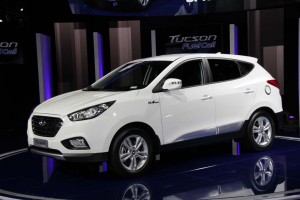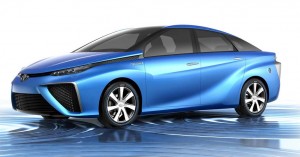Toyota will launch production of its first commercially available hydrogen fuel-cell vehicle before the end of the year, according to a report from Japan. That would appear to be months ahead of its original plans.
Toyota, which hasn’t changed its stance of “2015 or sooner” for the release of the car, first revealed plans to get into the hydrogen car market last autumn, at the biennial Tokyo Motor Show. It has produced a number of prototypes in years past, but the Japanese giant has been suggesting that it might go the fuel-cell route as an alternative to depending on battery-electric vehicles to meet tough new Zero-Emission Vehicle, or ZEV standards.
The first Toyota battery cars would come in at around 8 million yen, according to the Japan Times, which would work out to a hefty $78,000, though the English-language publication noted that by the beginning of the next decade, Toyota would like to trim that to somewhere between 3 million to 5 million yen, or between $30,000 and $50,000 at current exchange rates.
Toyota has indicated it will introduce a modified version of its Tokyo concept vehicle in the US. – with sales concentrated in Southern California, where there is a small but growing network of hydrogen fueling stations. It is unclear whether it will reduce the price of the American fuel-cell vehicle in order to build demand – much as automakers have done to spur sales of battery-electric vehicles.

Hyundai is just bringing its Tucson-based hydrogen fuel-cell vehicle to market in Southern California.
Hyundai, which this month is launching sales of its own hydrogen car, plans to offer the Tucson Fuel-Cell Vehicle for a flat lease price of $499 a month, a figure that will include all the hydrogen a customer can use.
(For more on the new Hyundai hydrogen-powered Tucson, Click Here.)
Honda, meanwhile, also plans to get into the hydrogen car market or, more accurately, return to it with a follow-up to the FCX fuel-cell vehicle it leased a few years back, also in Southern California. And Mercedes-Benz and General Motors are also planning entries into the segment. The German maker also is testing a small number of so-called F-Cell hydrogen cars.
Hydrogen power is seen by some as the ultimate clean fuel. The lightweight gas is combined with oxygen from the air inside a device called a fuel-cell stack. That creates a flow of current that can be used to power the same sort of electric motor drive system found in a battery car. But fuel cells can offer better range than current lithium-ion batteries, and hydrogen vehicles can be refueled in minutes, far faster than a battery-car can be recharged. Meanwhile, the only exhaust gas is water vapor.
(Daimler plans to bet big on fuel-cell technology. Click Here for details.)
Fuel-cell technology has undergone significant improvements in recent years, producing more power out of a smaller, lighter, less expensive stack – though the technology still has a cost penalty compared to a conventional, internal combustion engine.
The biggest problem is the lack of a hydrogen production and distribution network. Toyota says it plans to cooperate in efforts to make hydrogen more readily available. The State of California has already approved a fund to expand the distribution network to around 100 filling stations by decade’s end.
(Not everyone is confident hydrogen is the fuel of the future. Click Here for that story.)
Toyota officials haven’t responded yet to a request for comment by TheDetroitBureau.com as to why they reportedly want to move up the production date of their new hydrogen car. It is, according to the Japan Times, set to go into production at the maker’s big plant in Motomachi, in Japan’s Aichi Prefecture. Also unclear is when the vehicle will reach the American market, though Toyota has suggested that should come sometime in 2015.


Why does every car maker except perhaps Porsche think they need to make a hybrid car really FUGLY looking? Is this their way of getting attention? Maybe they are unaware that a nicely styled car gets a lot more attention than a really FUGLY car.